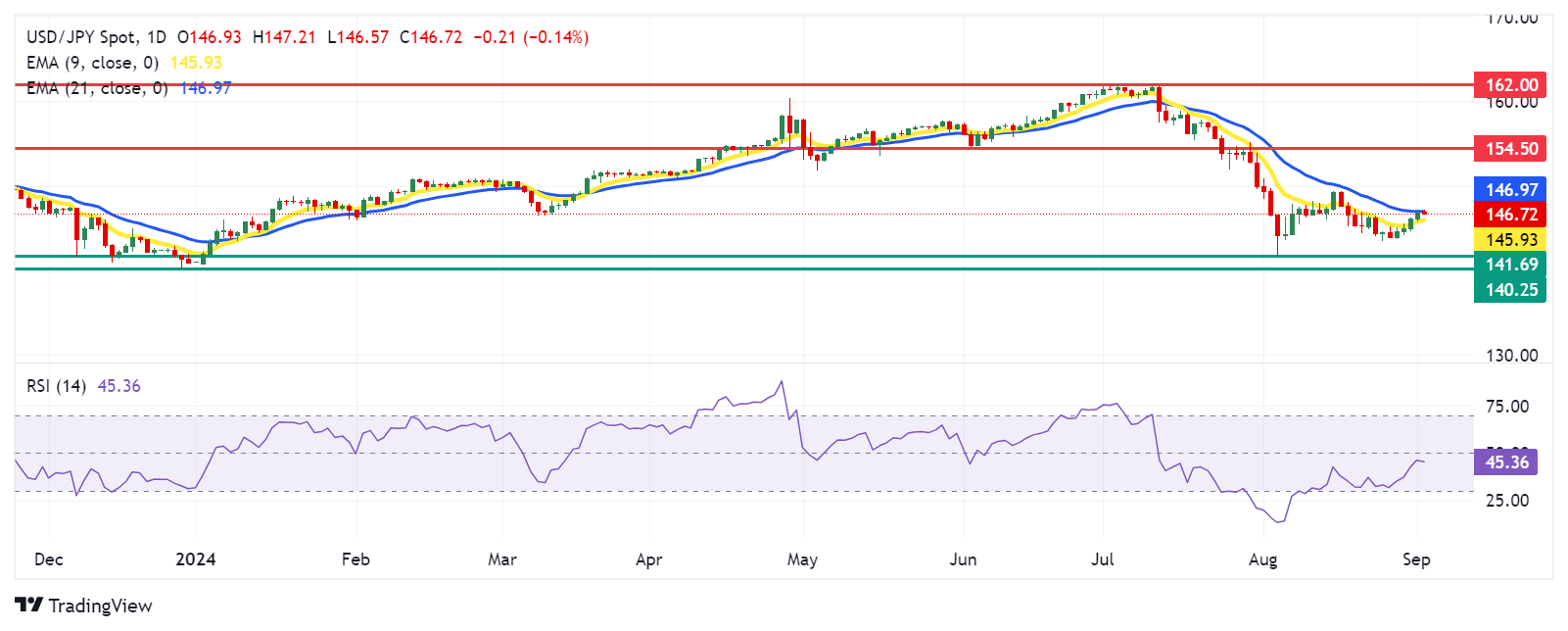Japanese Yen inches higher due to rising risk aversion

- The Japanese Yen edges higher as the government will allocate ¥989 billion to fund energy subsidies.
- The JPY faced challenges as weak Japanese manufacturing data fueled speculation that the BoJ might postpone further rate hikes.
- The US Dollar receives support from improving Treasury yields.
The Japanese Yen (JPY) ended its four-day losing streak, edging higher against the US Dollar (USD) on Tuesday. However, the JPY encountered headwinds as weak Japanese manufacturing data fueled speculation that the Bank of Japan (BoJ) might postpone further rate hikes.
Japan will allocate ¥989 billion to fund energy subsidies in response to rising energy costs and the resulting cost-of-living pressures. This government intervention could potentially contribute to inflation. The Bank of Japan’s (BoJ) hawkish monetary policy stance has been further reinforced by a recent increase in Tokyo’s inflation. Meanwhile, Japanese companies reported a sharp rise in capital spending for the second quarter.
The downside of the USD/JPY pair could be restrained as the US Dollar strengthens amid improving Treasury yields. Traders will focus on upcoming US employment data, particularly the August Nonfarm Payrolls (NFP), for further insights into the potential timing and scale of Fed rate cuts.
Daily Digest Market Movers: Japanese Yen edges higher due to hawkish BoJ
- The US Bureau of Economic Analysis reported on Friday that the headline Personal Consumption Expenditures (PCE) Price Index increased by 2.5% year-over-year in July, matching the previous reading of 2.5% but falling short of the estimated 2.6%. Meanwhile, the core PCE, which excludes volatile food and energy prices, rose by 2.6% year-over-year in July, consistent with the prior figure of 2.6% but slightly below the consensus forecast of 2.7%.
- Tokyo’s Consumer Price Index (CPI) increased to 2.6% year-on-year in August, up from 2.2% in July. Core CPI also rose to 1.6% YoY in August, compared to the previous 1.5%. Additionally, Japan’s Unemployment Rate unexpectedly climbed to 2.7% in July, up from both the market estimate and June’s 2.5%, marking the highest jobless rate since August 2023.
- Federal Reserve Bank of Atlanta President Raphael Bostic, a prominent hawk on the FOMC, indicated last week that it might be “time to move” on rate cuts due to further cooling inflation and a higher-than-expected unemployment rate. FXStreet’s FedTracker, which gauges the tone of Fed officials’ speeches on a dovish-to-hawkish scale from 0 to 10 using a custom AI model, rated Bostic’s words as neutral with a score of 5.6.
- The US Gross Domestic Product (GDP) grew at an annualized rate of 3.0% in the second quarter, exceeding both the expected and previous growth rate of 2.8%. Additionally, Initial Jobless Claims showed that the number of people filing for unemployment benefits fell to 231,000 for the week ending August 23, down from the previous 233,000 and slightly below the expected 232,000.
- Japan’s Finance Minister Shunichi Suzuki stated last week that foreign exchange rates are influenced by a variety of factors, including monetary policies, interest rate differentials, geopolitical risks, and market sentiment. Suzuki added that it is difficult to predict how these factors will impact FX rates.
Technical Analysis: USD/JPY tests the 21-day EMA resistance near 147.00
USD/JPY trades around 146.70 on Tuesday. Daily chart analysis shows the nine-day Exponential Moving Average (EMA) is lower than the 21-day EMA, indicating a bearish trend in the market. Additionally, the 14-day Relative Strength Index (RSI) remains below 50, indicating that the bearish trend is still in effect.
In terms of support, the USD/JPY pair might first test the nine-day Exponential Moving Average (EMA) at around 145.91. If the pair falls below this level, it could move toward the seven-month low of 141.69, recorded on August 5, and subsequently find the next support level around 140.25.
On the upside, the USD/JPY pair may test the immediate barrier at the 21-day EMA at 146.97. A break above this level could support the pair to approach the psychological level of 150.00 level, followed by the 154.50 level, which has shifted from support to resistance.
USD/JPY: Daily Chart
Japanese Yen PRICE Today
The table below shows the percentage change of Japanese Yen (JPY) against listed major currencies today. Japanese Yen was the strongest against the Australian Dollar.
| USD | EUR | GBP | JPY | CAD | AUD | NZD | CHF | |
|---|---|---|---|---|---|---|---|---|
| USD | 0.15% | 0.16% | -0.29% | 0.22% | 0.71% | 0.85% | 0.15% | |
| EUR | -0.15% | 0.01% | -0.42% | 0.07% | 0.55% | 0.59% | -0.01% | |
| GBP | -0.16% | -0.01% | -0.44% | 0.06% | 0.55% | 0.59% | -0.02% | |
| JPY | 0.29% | 0.42% | 0.44% | 0.50% | 0.98% | 0.94% | 0.40% | |
| CAD | -0.22% | -0.07% | -0.06% | -0.50% | 0.46% | 0.44% | -0.08% | |
| AUD | -0.71% | -0.55% | -0.55% | -0.98% | -0.46% | -0.06% | -0.57% | |
| NZD | -0.85% | -0.59% | -0.59% | -0.94% | -0.44% | 0.06% | -0.50% | |
| CHF | -0.15% | 0.01% | 0.02% | -0.40% | 0.08% | 0.57% | 0.50% |
The heat map shows percentage changes of major currencies against each other. The base currency is picked from the left column, while the quote currency is picked from the top row. For example, if you pick the Japanese Yen from the left column and move along the horizontal line to the US Dollar, the percentage change displayed in the box will represent JPY (base)/USD (quote).
